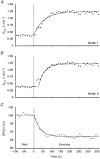Inferences from pulmonary O2 uptake with respect to intramuscular [phosphocreatine] kinetics during moderate exercise in humans
- PMID: 10421675
- PMCID: PMC2269465
- DOI: 10.1111/j.1469-7793.1999.0921p.x
Inferences from pulmonary O2 uptake with respect to intramuscular [phosphocreatine] kinetics during moderate exercise in humans
Abstract
1. In the non-steady state of moderate intensity exercise, pulmonary O2 uptake (Vp,O2) is temporally dissociated from muscle O2 consumption (Vm,O2) due to the influence of the intervening venous blood volume and the contribution of body O2 stores to ATP synthesis. A monoexponential model of Vp,O2 without a delay term, therefore, implies an obligatory slowing of Vp,O2 kinetics in comparison to Vm, O2. 2. During moderate exercise, an association of Vm,O2 and [phosphocreatine] ([PCr]) kinetics is a necessary consequence of the control of muscular oxidative phosphorylation mediated by some function of [PCr]. It has also been suggested that the kinetics of Vp,O2 will be expressed with a time constant within 10 % of that of Vm,O2. 3. Vp,O2 and intramuscular [PCr] kinetics were investigated simultaneously during moderate exercise of a large muscle mass in a whole-body NMR spectrometer. Six healthy males performed prone constant-load quadriceps exercise. A transmit-receive coil under the right quadriceps allowed determination of intramuscular [PCr]; Vp,O2 was measured breath-by-breath, in concert with [PCr], using a turbine and a mass spectrometer system. 4. Intramuscular [PCr] decreased monoexponentially with no delay in response to exercise. The mean of the time constants (tauPCr) was 35 s (range, 20-64 s) for the six subjects. 5. Two temporal phases were evident in the Vp, O2 response. When the entire Vp,O2 response was modelled to be exponential with no delay, its time constant (tau'Vp,O2) was longer in all subjects (group mean = 62 s; range, 52-92 s) than that of [PCr], reflecting the energy contribution of the O2 stores. 6. Restricting the Vp,O2 model fit to phase II resulted in matching kinetics for Vp,O2 (group mean tauVp,O2 = 36 s; range, 20-68 s) and [PCr], for all subjects. 7. We conclude that during moderate intensity exercise the phase II tauVp,O2 provides a good estimate of tauPCr and by implication that of Vm,O2 (tauVm,O2).
Figures






References
-
- Babcock MA, Paterson DH, Cunningham DA, Dickenson JR. Exercise on-transient gas exchange kinetics are slowed as a function of age. Medicine and Science in Sports and Exercise. 1994;26:440–446. - PubMed
-
- Barstow TJ, Buchthal S, Zanconato S, Cooper DM. Muscle energetics and pulmonary oxygen uptake kinetics during moderate exercise. Journal of Applied Physiology. 1994a;77:1742–1749. - PubMed
-
- Barstow TJ, Buchthal S, Zanconato S, Cooper DM. Changes in the potential controller of human skeletal muscle respiration during incremental calf exercise. Journal of Applied Physiology. 1994b;77:2169–2176. - PubMed
-
- Barstow TJ, Lamarra N, Whipp BJ. Modulation of muscle and pulmonary O2 uptakes by circulatory dynamics during exercise. Journal of Applied Physiology. 1990;68:979–989. - PubMed
-
- Beaver WL, Lamarra N, Wasserman K. Breath-by-breath measurement of true alveolar gas exchange. Journal of Applied Physiology. 1981;51:1662–1675. - PubMed
Publication types
MeSH terms
Substances
LinkOut - more resources
Full Text Sources
Medical

